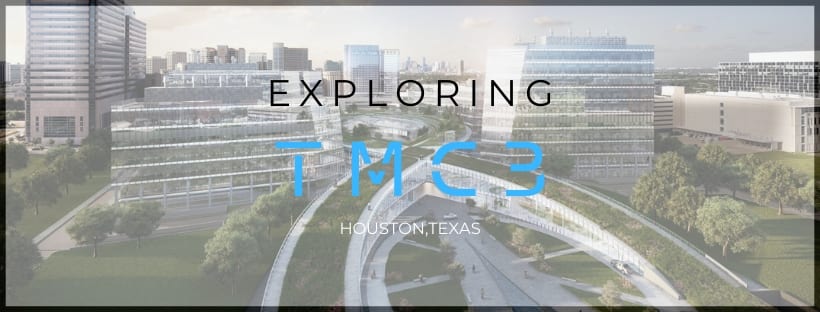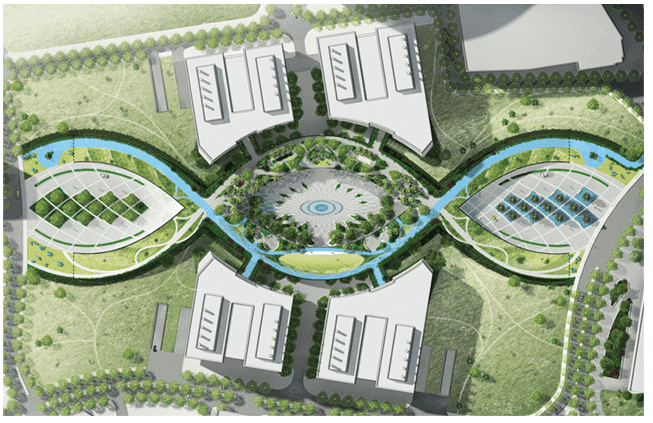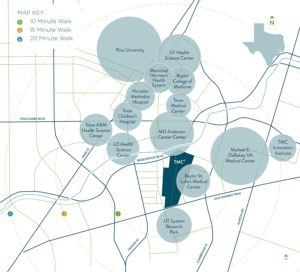
Exploring TMC³ – Houston’s $1.5 Billion Medical Research Campus
The TMC³ project at the Texas Medical Center in Houston, Texas is a massive $1.5 billion dollar project that is expected to change the physical, medical and economic landscape of the Houston market forever.
With a goal of establishing Texas as the “Third Coast” for life sciences research, the collaborative project intends to help Texas compete directly with Boston and San Francisco in medical research and discovery.
Read on to learn more about:
- TMC³ project sq footage
- TMC³ map, location and boundaries
- The architect responsible for the TMC³ project
- TMC³ timeline and estimated completion date
TMC³ Project Overview
Plans call for new construction of a new 30-acre medical research campus at the Texas Medical Center campus with 1.5 million square feet of space.
The development will contain laboratories, plazas, restaurants, and other commercial spaces.
The campus will also have an elevated park, a 19-story hotel with 410 rooms, and 50,000 square feet of conference space.
There are 5 founding TMC³ institutions that are collaborating on the project:
Texas Medical Center, Baylor College of Medicine, Texas A&M University Health Science Center, The University of Texas Health Science Center (UTHealth), and The University of Texas MD Anderson Cancer Center.


Tune into the podcast on TMC³ to learn more.
TMC3 FAQS
WHO IS THE TMC³ ARCHITECT?
Boston-based Elkus Manfredi is the architecture firm for the TMC³ project.
WHEN IS THE TMC³ GROUNDBREAKING?
The TMC³ is expected to break ground in Q1 2020.
WHEN WILL THE TMC³ PROJECT BE COMPLETE?
The TMC³ project in Houston, Texas is expected to be complete by Q4 2022.
Get details on up to 35 additional construction projects in Texas or nationwide with a free trial via www.MedicalConstructionData.com/Free
THE CONSTRUCTIONWIRE PODCAST TRANSCRIPT
Luke O’Brien: Hello listeners and welcome to the eighth episode of the Construction Wire Podcast. Remember that this is a podcast that twice a month takes the blue pencil to the biggest news in the construction market and makes it accessible to you. I’m your host, Luke O’Brien, and as always this podcast is made possible by BuildCentral, the Chicago-based front runner in construction market research whose data keeps you ahead in the game and knowledgeable to every opportunity available, whether you are a vendor or a supplier, contractor or developer.
Luke O’Brien: We have an amazing show for you today and another huge project to discuss, but I’d like to start just by asking you audience a question. It’s kind of a funny question, perhaps not immediately recognizable as a construction related question on its face, but you’ll see where I’m going with this. My question is, where do you think you would receive the best medical care in the United States if you got sick? Perhaps that’s not necessarily a fun thought, but it is an important one and I bet you that I could guess where your mind goes.
Luke O’Brien: When you think of medical prestige in the United States, you think of places like Johns Hopkins Hospital in Baltimore or perhaps Massachusetts General Hospital in Boston, both of which are on the far east coast, and maybe you even think of the UCSF Medical Center in San Francisco or the UCLA Medical Center in Los Angeles. Both of those obviously are on the far west coast. But where else? Where else comes to mind for quality medical care in the United States right now? That is the subject of our show today. The answer that I am proposing to where you can find some of the best medical care and medical research being conducted in the United States is not on the east or west coast, but on the so-called third coast, near the golf in [Dramwell 00:02:06] Place, Houston, Texas.
Luke O’Brien: I’m sure you’re asking yourself by now, why is he talking about medical care, and why is he talking about medical care in Houston, Texas specifically? Well, the reason is that the project that we’re going to be discussing today is a medical build. It’s a large medical build. In fact, it will be essentially a 37 acre addition to what is already considered to be the largest medical complex in the world. That’s the Texas Medical Center again in Houston and the name of the project in question, as you might already have guessed, is the TMC3, or TMC cubed as it’s written. The TMC3 is the long planned expansion to the Texas Medical Center that has been in the news recently as it is set to break ground early next year in 2020.
Luke O’Brien: We knew that we had to cover this project at some point. So many aspects of the TMC3 are unique from its almost grandiose aim of becoming the new hub of medical expertise in the United States, beating out places like Boston and San Francisco all the way to how its architecture and design are social in nature rather than purely academic as you might expect. We will be getting into all that I promise. In fact, the majority of this episode is an interview that I was lucky enough to snag with a colleague of mine named Andrew Struska. He is the medical research supervisor here at BuildCentral and an expert in large medical campus projects like the TMC3.
Luke O’Brien: We will be getting to that interview soon so you can hear exactly what the TMC3 will entail. But first, I think it’s important just to briefly provide you with a little background on the genesis of the project, on the genesis of the TMC3. Now, the institutes behind the TMC3 are fivefold and the lineup includes the Texas Medical Center, first, followed by the Baylor College of Medicine, the Texas A&M University Health Science Center, the University of Texas Health Science Center or UTHealth and the University of Texas MD Anderson Cancer Center.
Luke O’Brien: Now, why did these institutes decide to move forward with this project? What is the incentive behind the TMC3. As you will hear in my interview with Andrew, the TMC3 is expected to provide over $5 billion in economic stimulus to the surrounding economy, just as a center of commerce eventually. That is what it is projected to do for the surrounding community, again, eventually. But what you have to remember is that to get there, it’s projected to cost around $1.5 billion alone to build. That’s the current estimate anyways.
Luke O’Brien: Again, what is the current incentive? To that end, I would like to refer to a May 2nd, 2019 article that appeared in Forbes Magazine. Now, this article was written by Cynthia Lescalleet about the TMC3 and to quote, “An integrated biotech and bioscience center for innovation, collaboration and connectivity between its clinical, research and entrepreneurial participants, TMC3 intends to establish Houston as the Third Coast for life sciences, thus the number three in its name, and to better compete with similar entities on the east and west coasts, meaning Boston and San Francisco, in advancing medical research and discovery.”
Luke O’Brien: So there you have it. Houston is seeking to establish itself as a medical destination. In fact, it is currently ranked second in the nation as an emerging life sciences metro in the United States, right behind Seattle, according to a recent study conducted by Los Angeles based CBRE Group Incorporated. In effect, the TMC3 is meant to further that. So without taking up any more time, let’s dive into my interview with Andrew Struska, again, the medical research supervisor with us at BuildCentral in order to get a better understanding of this project. Let’s take a listen.
Luke O’Brien: Thank you for joining us for our conversation today on the TMC3 Medical Innovation Campus project in Houston. I am joined by my colleague today, his name is Andrew Struska and he is the medical research manager here at BuildCentral and we figured that he would be the perfect individual to discuss this project with us today. So Andrew, thanks for joining us. How are you doing?
Andrew Struska: I’m doing good. Thank you for having me.
Luke O’Brien: Yeah. Absolutely, man. Before we start, Andrew, I just want to extend a congratulations. I know you won’t be here much longer at BuildCentral. You are… I know you signed on for another job and are off to greener pastures, but congratulations man. All the world to you, that’s fantastic. I’m glad you could at least be with us here today.
Andrew Struska: Well, thank you. I appreciate that. It’s been a good several eight years I’ve been here, but it’s home. Doing exciting things in the future too.
Luke O’Brien: Very cool. All right. So, let’s just jump right in. I know a lot of people have been sort of waiting on pins and needles for news about this project in particular. Again, it’s called the TMC3 and that’s short for, what is that? Texas Medical Center. And I think actually how it’s written is TMC cubed, right? Like TMC to the power of three, is that right?
Andrew Struska: That is correct, yes.
Luke O’Brien: Yeah. It’s kind of a funny name, but definitely an interesting project. Andrew, I’m hoping you could just give just a really brief overview of what it is, just sort of the scope and idea behind the TMC3.
Andrew Struska: Sure. So, in Houston there is already the Texas Medical Center, which is a collaborative medical research clinical campus that is operated by quite a few healthcare entities just north of this planned campus, which is going to be about 1.5 million square feet and it’s going to be sort of where they want to expand their research footprint.
Luke O’Brien: Got you. Do you know… 1.5 million square feet, I had seen that that was sort of planned within 30 or so acres. 37 acres I think.
Andrew Struska: Yeah. Yeah. I think that sounds about right to me as well.
Luke O’Brien: Very cool. Very cool. I think on their website, I had actually taken a pic at the tmc.edu website. Listeners, you can check this out at www.tmc.edu\TMC3. And I know that they had quoted, it looks like it’s, yeah exactly. 1.5 million square feet for the collaborative research campus, 37 acres and I think if you break that down even further, they’re looking at 250,000 square feet of core labs and amenities and it will also include 125,000 square feet of commercial and retail space and another 125,000 square feet of shared research facilities. Andrew, I’m hoping you could… I’ve seen renderings of the project myself. I know that they are planning sort of like a DNA strand, helix feature within the project. I’m hoping you could sort of describe what that looks like in practice for our listeners.
Andrew Struska: Sure. So it’s going to be a double helix sort of centered piece for the campus that’s going to act as a, I guess… Well, here in Chicago we have the 606 as sort of an elevated park. That’s basically what this is going to be that ties the campus together.
Luke O’Brien: Awesome.
Andrew Struska: In New York, we have the Highline, I think it’s called, kind of similar as well.
Luke O’Brien: For you listeners, the main feature of the TMC3, back when it began its planning, we at BuildCentral, we’ve been following it since round about early 2018 and in the early planning stages, this project was going to feature what was actually going to be a double helix looking building, a building that was supposed to look like a DNA strand as sort of the centerpiece of this medical research collaborative space. They decided not to go vertical, it’s horizontal now.
Luke O’Brien: So it’s going to be a large DNA shaped walking route promenading through the center of this project and it’s going to be sort of crisscrossed pathways. So, if you were to look at it from above, you would see a DNA strand sort of necklace through the center of this development. It’s quite beautiful. That actually sort of leads me into I think what I consider to be the most interesting sort of design aspect of this project is how it’s really community based. Andrew, would you agree with that?
Andrew Struska: Yeah, I think they’re definitely trying to push for the collaborative environment, which has been a big founding principle of the existing Texas Medical Center and a big philosophy of all these kinds of cooperating universities and healthcare systems within them. So yeah, this is going to be kind of a part of their big push I think to bring in a lot of sort of industry to collaborate with them on just different research endeavors. And I think just this overall landscaping and aesthetic that they’re going forward with this double helix kind of gives a visual tie to all that.
Luke O’Brien: An incentive that you would normally think would drive people to work in a new space like this would be really exceptional research facilities or state-of-the-art labs, that kind of thing. I’m sure of which the TMC3 will feature, but the designer of the TMC3, the sort of architect behind this design that they propose is Elkus Manfredi, and they, representatives from Elkus Manfredi have been quoted as saying that the initiative that they’re proposing isn’t necessarily just facilities to attract talent to come work here.
Luke O’Brien: It’s really the social design of the entire campus. It is this sort of walkable pathway that people love. A lot of the ground floors in the buildings that they’re going to be putting up will feature ground floor retail and food halls and restaurants, places to eat, areas you can ride your bike. So, I really think it’s a unique approach to attracting talent. They’re really focusing on the social aspect of this development, which I think is unique for a medical project.
Andrew Struska: It’s definitely something, it’s just sort of like the Silicon Valley mentality of, how do we get the best tiered talent into our facilities? And I think that’s definitely what they’re incorporating here. You mentioned Elkus, they’re no stranger to this sort of thing. They’ve done a ton of research campuses for healthcare, mostly on the east coast, places like the Vertex Pharma campus, the Brode or Broad, I assume Brode Institute for MIT. Yep?
Luke O’Brien: For MIT and Harvard. Yeah, I saw that. They also did the Stanley Building at the Broad Institute in Cambridge, I think, and the New York Genome Center as well. Yeah, I did see that they have done quite a number of these. I mean, for those of you listeners who aren’t aware, Elkus Manfredi, again, the architects behind this project, they were selected to be part of the development team on the TMC3 back in May of 2019, I think it was May of 2019. They were selected alongside Transwestern Development Company and then Von Construction.
Luke O’Brien: And those three entities, again Elkus Manfredi, Transwestern Development and Von Construction will serve as the architectural and development team as well. So I know that a big driving factor for Houston to move forward with this project was that it is really trying to establish itself as, what they call it on the TMC website is the third coast for medicine. We have San Francisco on the west coast and then we have Boston on the east coast who are the main centers for medical innovation currently. And the idea behind TMC3 is to create the third coast. This is going to be Houston establishing themselves alongside San Francisco and Boston. And I’m wondering if you sort of feel the same way about that Andrew, if that’s kind of like the idea behind this.
Andrew Struska: Yeah, I think so. In a lot of their marketing materials, they’re, like you said, specifically calling out San Francisco and Boston, or they’re branding, they’re calling themselves the third coast.
Luke O’Brien: I would agree. What I haven’t seen a whole lot reported on so far is the specific sciences that are going to be included in the project. I’m sure they haven’t gotten that far yet. But branding wise right now, like you mentioned, I know that they’re trying to attract the brightest minds in life sciences. And for those of you unfamiliar with life sciences, that sort of general human health. It is… the focus of the TMC3 is going to be broad spectrum. It’s not a specific cancer center or anything like that. And what exactly that will incorporate sort of has yet to be seen. I haven’t seen a whole lot of specifics about what type of facilities are going to be included.
Andrew Struska: I saw something today about sort of robotics partners. They’re probably going to get further along in development and start seeking out industry partners, is my guess. Just seeing who’s going to be interested in terms of collaborating. So, we’ll probably see clinical research, things in like cancer and cellular biology getting involved.
Luke O’Brien: Got you.
Andrew Struska: And we’ll also probably see things like robotics as well, operating rooms and maybe even some nonclinical partners or at least… not in the traditional sense, maybe new tech like applications, getting people to sort of adhere to regimens and communicate better maybe and just better patient experience, that kind of thing.
Luke O’Brien: I can definitely see that happening. Again, it just all goes back to branding as well, doesn’t it? They actually call a medical campus, they’re calling this medical campus a live, work, play campus. And that in my experience researching construction, that is really a term reserved for the multifamily sector. I do understand that you can apply the live, work, play designation to a campus like this if it’s walkable, if it’s beautiful, if it’s green, if it attracts sort of the residential surrounding community to participate in the retail and the restaurants. But definitely I think that the live, work, play mentality is unique for a medical campus and perhaps just the fact that they’re marketing the campus like that is the reason why we haven’t seen too many of the really tech and spec aspects of it yet.
Andrew Struska: Right. And I think you kind of touched on about how this live, work, play branding and multifamily, how you often see those hand to hand together. I genuinely see this as Houston, as a city along with these universities in this collaborative environment trying to make a push for just national recognition. The fact that it’s in Houston, I think it gives them a lot of opportunities to grow more than you would see in say San Francisco or Boston. And I know they were putting out figures that it’s supposed to have a 5.2 billion economic impact just on the city as a whole.
Luke O’Brien: I didn’t see that. Yeah. Okay.
Andrew Struska: Yeah. And so you see… like when you see San Francisco in development and like just the boom that tech had there. Looking at Houston, its stalls… Between San Francisco and Boston, they both are about 2,400 to 3,500 square miles in just the metro area. Houston is about 8,300 square miles in its metro area. So I think it can start pushing out of its boundaries or pushing up in ways maybe those two markets couldn’t.
Luke O’Brien: I do know they are, I think the TMC3 is looking at breaking ground sometime in early 2020, I think the tentative opening date. I’m not sure if this is substantial completion for the entire project. I expect it won’t be, but I think the first facilities are looking to be opened around sometime in 2022. So we’re looking at a two year construction schedule for at least the first projects going into the development.
Luke O’Brien: One other big aspect of the TMC3 that really caught my eye, just… Listeners, if you’re familiar with the last two episodes we did on the Construction Wire Podcast, we covered both the 78 mixed-use development in Chicago and Lincoln yards in Chicago. Part of the 78 was… a big focus that they were doing was going to be a large innovation center right in the middle of the 78. These innovation centers, they’re collaborative spaces, they usually have a large atrium in the center. They attract a lot of different minds so to speak. They seem to be a fixture in developments like this and that carries over into the TMC3 project as well.
Luke O’Brien: Actually to quote from the tmc.edu website, again, this is in regards to their own innovation center that there’ll be building within the campus as well. “The areas main communal building at the center of the TMC3 campus will now take the form of a bustling nerve center called TMC3 Collaborative. The ground floor of the building will boast an open central atrium used for the gathering of researchers to share transformational projects alongside a diverse mix of food and beverage concepts. The upper floors will house shared collaborative institutional research space and industry partner facilities.”
Luke O’Brien: I thought that that was important to note just because we’re seeing more and more of these almost pavilion style buildings at the nerve center of these developments and that definitely garners public interest for sure. It certainly did for the 78 and I expect it will for the TMC3 as well as more information comes out about this, about the TMC3 Collaborative, what they’re calling this building. Andrew, thank you so much for coming on the show, man. Thanks for offering some insight. I knew that you would have some outside of the box thoughts on this.
Andrew Struska: Yeah, [inaudible 00:23:20]. Thanks for having me on. Glad to be here.
Luke O’Brien: All right, take care Andrew.
Andrew Struska: Thanks. You too.
Luke O’Brien: Bye. And I believe that that is all that we have time for today. Thank you everyone. I hoped you enjoyed the show. We will be back with more content, news and discussion about the world of construction soon, but in the meantime, if you could hit the subscribe button on whatever podcast platform that you’re using to listen in, whether it’s Apple Podcast, Google Play, Stitcher or whatever else and give us a follow, that would be amazing.
Luke O’Brien: Also, if you like the episode, go ahead and leave us a five star review, that helps us out of ton. We love to see that and thanks again for listening to the Construction Wire Podcast brought to you by BuildCentral construction data; covering new projects in the commercial, hospitality, medical, and multifamily construction spaces.
You can grab your free trial and demo today at www.constructionwire.com. Again, www.constructionwire.com. Take care. We’ll see you soon.


